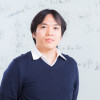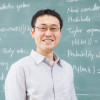141 events in 2021
-
Seminar

Hidden Markov Models and their applications
December 23 (Thu) at 10:00 - 11:00, 2021
Takashi Okada (Senior Research Scientist, RIKEN Interdisciplinary Theoretical and Mathematical Sciences Program (iTHEMS))
The Hidden Markov models (HMM) have been used in a variety of fields for different purposes. I am going to review statistical inference methods associated with HMM & related biological problems. As an example of their applications, I'll also present my research on the SARS-CoV-2 evolution.
Venue: via Zoom
Event Official Language: English
-
Seminar

Quantum metric of topological and non-topological insulators in AMO and other systems
December 20 (Mon) at 13:30 - 15:00, 2021
Tomoki Ozawa (Associate Professor, Advanced Institute for Materials Research (AIMR), Tohoku University)
Recently, the concept of quantum geometry is attracting great interests in various areas of condensed matter and AMO physics. Quantum geometry tells how much the quantum states "change" as one moves in a parameter space, and is closely related to the topology of the quantum states. Quantum geometric tensor is often used to characterize the geometry, whose real part is the quantum metric and the imaginary part is the Berry curvature. Although Berry curvature is rather well-studied in the context of topological insulators and superconductors, less has been known about the quantum metric. However, experiments detecting the quantum metric have appeared in the past couple of years and interest in quantum metric is indeed growing. In this talk, I first explain basics of quantum metric and its recent experimental observations. I then discuss various aspects of quantum metric, including its relation to localization, topology, and the Kähler geometry.
Venue: via Zoom
Event Official Language: English
-
Seminar
Revisiting Standard Methods for Phylogenetic Tree Inference
December 16 (Thu) at 10:00 - 11:00, 2021
Motomu Matsui (Research Associate, Graduate School of Science, The University of Tokyo)
Phylogenetic tree inference is the foundation to answer any biological questions, for example, how the living systems were established. However, the existing methods show poor performance to infer the phylogenetic tree when constructing an informative multiple sequence alignment (MSA) is difficult. In this talk, I will first review the current problems in phylogenetics, then introduce the graph splitting (GS), and edge perturbation (EP) method. The GS method rapidly reconstructs a protein superfamily-scale phylogenetic tree using a graph-based approach; evolutionary simulation showed that the GS method can accurately reconstruct phylogenetic trees when sequences substantially diverge. The EP method is the bootstrap-like method using pairwise sequence alignment (PSA) instead of MSA, which can provide reliable measurements on the estimated branches. In addition, we can rapidly and reliably reconstruct a phylogenetic tree with problematic MSA switching NJ+EP and GS+EP methods, because the EP method can be applied to the NJ method. These methods not only improve the accuracy of phylogenetic tree inference, but they also could open the door for revisiting phylogenetics.
Venue: via Zoom
Event Official Language: English
-
Seminar
The FASER experiment
December 15 (Wed) at 17:00 - 18:00, 2021
Hidetoshi Otono (Assistant Professor, Research Center for Advanced Particle Physics, Kyushu University)
FASER, the ForwArd Search ExpeRiment, is an experiment dedicated to searching for light, extremely weakly-interacting particles at the LHC. Such particles may be produced in the LHC’s high-energy collisions and then decay to visible particles in FASER, which is placed 480 m downstream of the ATLAS interaction point. FASER, also includes a sub-detector, FASERν, designed to detect neutrino’s produced in the LHC collisions and to study their properties. This seminar will describe the physics motivations, detector design, expected performance of FASER, and current status, as well as the physics prospects.
Venue: via Zoom
Event Official Language: English
-
Seminar
Cosmological particle production as Stokes phenomena
December 15 (Wed) at 13:30 - 15:00, 2021
Yusuke Yamada (JSPS Research Fellowship for Young Scientists, Research Center for the Early Universe (RESCEU), The University of Tokyo)
Particle production from “vacuum” takes place in time-dependent backgrounds. In very early universe, particularly just after inflation, expanding metric as well as oscillating scalar fields play the role of such backgrounds. Mathematically, “particle production from vacuum” can be understood as “Stokes phenomena”, and such understanding enables us to estimate the amount of produced particles in a systematic way. In this talk, I will review the relation between Stokes phenomena and particle production. Then, from the Stokes phenomena viewpoint, I will (re)consider particle production associated with expanding universe, an oscillating scalar field, or both of them. I will also discuss the time evolution of particle number, and its relation to the ambiguity of “vacuum states”.
Venue: via Zoom
Event Official Language: English
-
Seminar
Magnetic field dependence of neutrino-driven core-collapse supernova models
December 10 (Fri) at 14:00 - 15:00, 2021
Jin Matsumoto (Assistant Professor, Keio Institute of Pure and Applied Sciences (KiPAS), Graduate School of Science and Technology, Keio University)
Massive stars can explode and release huge energy (typically 10^51 erg) at the end of their life. It is one of the most energetic explosions in the Universe and is called a core-collapse supernova. The impact of the magnetic field on the explosion mechanisms of the core-collapse supernova is a long-standing mystery. Recently, we have updated our neutrino-radiation-hydrodynamics supernova code (3DnSNe, Takiwaki et al. 2016) to include magnetohydrodynamics (MHD). Using this code, we have performed three-dimensional MHD simulations for the evolution of non-rotating stellar cores focusing on the difference in the magnetic field of the progenitors. Initially, 20 and 27 solar mass pre-supernova progenitors are threaded by only the poloidal component of the magnetic field, which strength is 10^10 (weak) or 10^12 (strong) G. We find that the neutrino-driven explosion occurs in both the weak and strong magnetic field models. The neutrino heating is the main driver for the explosion in our models, whereas the strong magnetic field slightly supports the explosion. In my talk, I will introduce the details of this mechanism.
Venue: via Zoom
Event Official Language: English
-
Seminar
Selective inference for testing trees and edges in hierarchical clustering and phylogeny
December 9 (Thu) at 10:00 - 11:00, 2021
Hidetoshi Shimodaira (Professor, Graduate School of Informatics, Kyoto University / Team Leader, Mathematical Statistics Team, RIKEN Center for Advanced Intelligence Project (AIP))
Bootstrap resampling is quite useful for computing “confidence values” or “p-values” of trees and edges. However, they are biased and may lead to false positives (too many wrong discoveries) or false negatives (too few correct discoveries) depending on the “curvature” of the boundary surface of a hypothesis region in the data space. In addition, we face the issue of selection bias because we tend to use the dataset twice for hypothesis selection and its evaluation. I will explain these two types of bias and show methods to adjust the confidence values.
Venue: via Zoom
Event Official Language: English
-
Seminar

Generalized Bernoulli process and computation of proportional areas for Venn diagram
December 8 (Wed) at 16:00 - 18:00, 2021
Ryosuke Iritani (Research Scientist, RIKEN Interdisciplinary Theoretical and Mathematical Sciences Program (iTHEMS))
*For detailed information about the seminar, please refer to the email.
Venue: via Zoom
Event Official Language: English
-
Seminar
The Conley index of topological dynamical systems
December 3 (Fri) at 16:00 - 18:00, 2021
Yosuke Morita (Assistant Professor, Department of Mathematics, Kyoto University)
The study of topological dynamical systems, i.e. continuous self-homeomorphisms (or continuous flows) on topological spaces, is important in both pure mathematics and applications. To each isolated invariant subset of a topological dynamical system, we can assign an invariant called the Conley index, which is (roughly speaking) a based space that describes the dynamics around the isolated invariant subset. It is used not only in the study of topological dynamical systems themselves but also in Manolescu’s construction of the Seiberg-Witten-Floer homotopy type (a spectrum-valued (3+1)-dimensional TQFT). In this talk, I am planning to explain a new construction of Conley indices, which is entirely non-homotopical and uses only basic general topology. *Please contact Keita Mikami or Hiroyasu Miyazaki's mailing address to get access to the Zoom meeting room.
Venue: via Zoom
Event Official Language: English
-
Seminar

Simulation-based inference for multi-type cortical circuits
November 29 (Mon) at 13:30 - 15:00, 2021
Enrico Rinaldi (Research Fellow, Physics Department, University of Michigan, USA)
In many scientific fields, ranging from astrophysics to particle physics and neuroscience, simulators for dynamical systems generate a massive amount of data. One of the crucial tasks scientists are spending their precious time on is comparing observational data to the aforementioned simulations in order to infer physically relevant parameters and their uncertainties, based on the model embedded in the simulator. This poses a problem because the likelihood function for realistic simulations of complex physical systems is intractable. Simulation-based inference techniques attack this problem using machine learning tools and probabilistic programming. I will start with an overview of the problem and explain the general application of simulation-based inference methods. Then I will describe an application of the methods to a model of neurons in the visual cortex of mice."
Venue: via Zoom
Event Official Language: English
-
Seminar
Self-adjointness from quantum-classical correspondence
November 26 (Fri) at 16:00 - 18:00, 2021
Koichi Taira (Assistant Professor, College of Science and Engineering Department of Mathematical Sciences, Ritsumeikan University)
Self-adjointness is a fundamental property of a linear operator in quantum mechanics. In physics, a self-adjoint operator is usually defined to be an operator which is own adjoint. However, this definition is in fact not satisfactory since a self-adjoint operator in this definition does not always have nice properties such as the spectral decomposition. Hence, in mathematics, a kind of completeness is also assumed in the definition of a self-adjoint operator. Here a natural question is how to judge whether an operator is self-adjoint. It has been believed that self-adjointness is closely related to completeness of the classical dynamics for a long time although a complete description of such relations has not been given so far. I am planning to talk about how self-adjointness is important in mathematical physics. Moreover, I will explain relations between self-adjointness and classical dynamics by introducing some examples. *Please contact Keita Mikami or Hiroyasu Miyazaki's mailing address to get access to the Zoom meeting room.
Venue: via Zoom
Event Official Language: English
-
Seminar
Imaging Theory of Optical Microscopy: Basic to Super Resolution
November 25 (Thu) at 13:30 - 15:00, 2021
Ryosuke Oketani (Assistant Professor, Physical Chemistry, Department of Chemistry, Faculty of Sciences, Kyushu University)
Optical microscopy is one of the sophisticated techniques to manipulate light based on well-established theories, as well as a powerful tool to observe living micro-organisms. The developments are still ongoing to overcome their limitations in observation. Recently, the invention of several super-resolution techniques has overcome the limit in spatial resolution caused by the wave nature of light. In this presentation, I discuss the theories behind optical microscopy. My talk starts with basic wave optics to explain how a lens forms and magnifies an image in a conventional microscope. Then, I introduce laser scanning microscopy as an alternative form to the microscope. At last, as a recent development, I discuss several super-resolution techniques, which utilize interesting theory to improve spatial resolution.
Venue: via Zoom
Event Official Language: English
-
Seminar
The graph removal lemma
November 19 (Fri) at 16:00 - 18:00, 2021
Shinichiro Seki (Assistant Professor, Aoyama Gakuin University)
We have recently proved an extension of the Green-Tao theorem on arithmetic progressions to number fields, in collaboration with Kai, Mimura, Munemasa and Yoshino. (Kai gave a talk on this result in March.) There are several promising approaches in this area, including ergodic theory and Fourier analysis, but we used a combinatorial tool, the relative hypergraph removal lemma proved by Conlon, Fox and Zhao. In the first half of this talk, I will give a survey of Szemerédi's regularity lemma and the graph removal lemma, and explain how to extend the removal lemma to the case of (weighted) hypergraphs. In the second half of this talk, I will present Fox's result on a quantitative version of the graph removal, and discuss the prospects for future research. *Please contact Keita Mikami's mail address to get access to the Zoom meeting room.
Venue: via Zoom
Event Official Language: English
-
Colloquium

The 17th MACS Colloquium
November 19 (Fri) at 15:00 - 18:00, 2021
Momoko Hayamizu (Assistant Professor, Faculty of Science and Engineering, School of Fundamental Science and Engineering, Waseda University / PRESTO Researcher, Japan Science and Technology Agency (JST))
Shigeru Kuratani (Chief Scientist, Evolutionary Morphology Laboratory, RIKEN Cluster for Pioneering Research (CPR) / Team Leader, Laboratory for Evolutionary Morphology, RIKEN Center for Biosystems Dynamics Research (BDR))15:00- Talk by Prof. Momoko Hayamizu 16:15- Talk by Dr. Shigeru Kuratani 17:15- Discussion
Venue: via Zoom
Event Official Language: Japanese
-
Seminar
Spatial structure in ecology: the effects of dispersal network structure on biodiversity pattern and stability in metacommunities
November 18 (Thu) at 10:00 - 11:00, 2021
Yuka Suzuki (Okinawa Institute of Science and Technology Graduate University (OIST))
Ecological dynamics typically take place at a large spatial scale. However, it has been challenging to study them at a scale as large as a country, continent, or ocean. In particular, while there are many studies that consider systems with multiple local patches (known as "metacommunities"), spatial structures assumed in these studies are mostly simple or focused on a particular structure, despite the diverse landscape structures seen in nature. Thus, to understand how spatial structures affect metacommunities in nature, we need to expand our understanding of the role of spatial structure in regulating biodiversity patterns and stability across diverse spatial structures. In my study, I addressed this issue by using computer simulation with theoretical and empirical spatial structures. In this talk, I will show how the use of computational tools and network theoretical concepts aided investigating unexplored aspects of spatial structure and dissecting the complex nature of spatial network structure. Results suggest that how dispersal pathways are distributed in the network space affects total diversity, and the number of patches in a metacommunity is the dominant spatial parameter that regulate stability. Such an improved understanding of the role of spatial structure could contribute to a better conservation planning as well.
Venue: via Zoom
Event Official Language: English
-
Seminar
Topological exchange statistics in one dimension
November 17 (Wed) at 17:00 - 18:15, 2021
Harshman Nathan (Department of Physics, American University, USA)
In two dimensions, the topological approach to exchange statistics predicts the existence of anyons obeying statistics given by the braid group. However, in one dimension the topological approach is ambiguous because particles cannot exchange without coincidence and scattering. I will review the topological approach and show how old controversies can be resolved using orbifolds (roughly, manifolds with symmetry) to describe configuration space for one-dimensional systems. Using orbifolds also predicts new topological physics, including possibilities for “traid group” statistics when there are three-body interactions in one dimension and non-abelian statistics for indistinguishable particles on a ring. *Detailed information about the seminar refer to the email.
Venue: via Zoom
Event Official Language: English
-
Seminar
Geometry in optical responses of quantum materials
November 15 (Mon) at 13:30 - 15:00, 2021
Naoto Nagaosa (Deputy Director, Group Director, Strong Correlation Theory Research Group, RIKEN Center for Emergent Matter Science (CEMS) / Professor, Department of Applied Physics, Graduate School of Engineering, The University of Tokyo)
Studies on optical responses of solids have the long history, and has been considered to be well established. However, a new development has been on-going recently, which explores the geometric nature of the electronic states in solids and its crucial role in optical processes. In this talk, I discuss the geometry and topology in the optical responses both in linear and nonlinear regimes, which includes (i) optical responses in clean superconductors, (ii) shift current in noncentrosymmetric quantum materials driven by Berry phases, and (iii) Riemannian geometry in nonlinear optical responses.
Venue: via Zoom
Event Official Language: English
-
Seminar
Confluence for the K-theoretic J-function
November 12 (Fri) at 16:00 - 18:00, 2021
Todor Milanov (Associate Professor, Kavli Institute for the Physics and Mathematics of the Universe (Kavli IPMU), The University of Tokyo)
I am planning to talk about my recent paper (1) written in collaboration with Alexis Roquefeuil. In the first part of the talk I would like to explain the background of our project: quantum differential equations and K-theoretic quantum q-difference equations in genus-0 Gromov--Witten theory. In the second part of the talk, I would like to explain our main result with an interesting application. Namely, under the assumption that the first Chern class of the tangent bundle is positive, we proved that the small J-function in quantum cohomology can be obtained as a limit q -->1 of the small J-function in quantum K-theory. In the case of a Fano toric manifold of Picard rank 2, we proved the K-theoretic version of an identity due to Iritani that relates the I-function of the toric manifold and the oscillatory integral of the toric mirror. In particular, our confluence result yields a new proof of Iritani's identity in the case of a Fano toric manifold of Picard rank 2. *Please contact Keita Mikami's mail address to get access to the Zoom meeting room.
Venue: via Zoom
Event Official Language: English
-
Seminar
Axions around rotating black holes
November 12 (Fri) at 14:00 - 16:00, 2021
Hirotaka Yoshino (Institute of Cosmophysics, Department of Physics, Graduate School of Science, Kobe University)
String theories indicate the existence of many axionlike scalar fields with light masses in addition to the QCD axion. If this is the case, an axion field around a rotating black hole extracts the energy of the black hole by the mechanism called the “superradiant instability”. Then, every astrophysical black hole is expected to wear a cloud of the axion. In this talk, I would like to give an overview on this topic, and introduce our numerical studies on the phenomena caused by the axion cloud at the last stage of the superradiant instability where the self-interaction of axions becomes important.
Venue: via Zoom
Event Official Language: English
141 events in 2021
Events
Categories
series
- iTHEMS Colloquium
- MACS Colloquium
- iTHEMS Seminar
- iTHEMS Math Seminar
- DMWG Seminar
- iTHEMS Biology Seminar
- iTHEMS Theoretical Physics Seminar
- Information Theory SG Seminar
- Quantum Matter Seminar
- ABBL-iTHEMS Joint Astro Seminar
- Math-Phys Seminar
- Quantum Gravity Gatherings
- RIKEN Quantum Seminar
- Quantum Computation SG Seminar
- Asymptotics in Astrophysics SG Seminar
- GW-EOS WG Seminar
- DEEP-IN Seminar
- NEW WG Seminar
- Lab-Theory Standing Talks
- QFT-core Seminar
- STAMP Seminar
- QuCoIn Seminar
- Number Theory Seminar
- Academic-Industrial Innovation Lecture
- Berkeley-iTHEMS Seminar
- iTHEMS-RNC Meson Science Lab. Joint Seminar
- RIKEN Quantum Lecture
- Theory of Operator Algebras
- iTHEMS Intensive Course-Evolution of Cooperation
- Introduction to Public-Key Cryptography
- Knot Theory
- iTHES Theoretical Science Colloquium
- SUURI-COOL Seminar
- iTHES Seminar
